Learning how to snell a circle hook is crucial for anglers aiming to enhance their catch rate while ensuring the health and safety of the fish. Properly snelling a hook improves the hook’s effectiveness, ensuring that it catches the fish’s mouth corner, reducing harm and facilitating catch and release. This technique is indispensable for those seeking to refine their fishing skills and ethics.
Circle hooks have a distinctive curvature that encourages the hook to catch in the corner of the fish’s mouth. This design minimizes damage to the fish and reduces the chances of gut-hooking, making them an essential tool for conservation-minded anglers. Their configuration also enhances hook-up rates, providing a more secure connection between the fish and the angler.
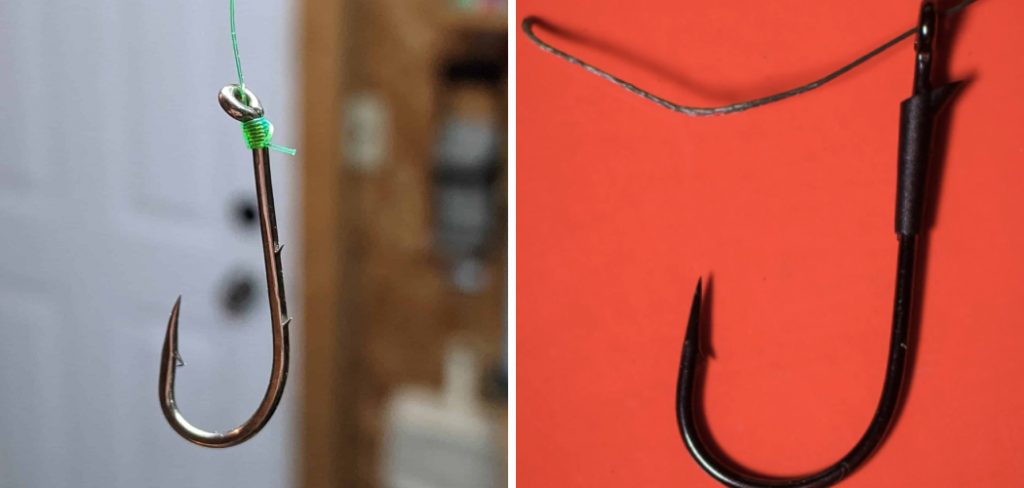
Mastering how to snell a circle hook improves the hook’s effectiveness and augments bait presentation, making it more appealing to target species. This technique ensures that the hook operates to its fullest potential, significantly increasing the chances of a successful catch. For those invested in the art and science of fishing, learning to properly snell a circle hook is a game-changer, combining ethical fishing practices with improved success rates.
Understanding the Anatomy of a Circle Hook
A. Identifying Key Components of a Circle Hook
A circle hook comprises several integral parts, each serving a specific function in making the hook an effective tool for catch-and-release fishing. The key components include the eye, where the fishing line is attached; the shank, which is the straight part leading to the curve; the bend, which gives the hook its circular shape; and the point and barb, which are designed to penetrate and hold onto the fish’s mouth securely without causing significant harm.
B. Recognizing the Unique Design Features of Circle Hooks
Circle hooks are distinctively designed with a curved shape that naturally steers the point towards the fish’s lip, rather than its gut, upon striking. This feature is critical in reducing mortality rates among released fish. The inward-pointing tip minimizes damage to the fish and decreases the likelihood of the hook being swallowed, a common issue with traditional J-hooks.
C. Understanding How Circle Hooks Function During Fishing
The functionality of circle hooks is a marvel of simplicity and effectiveness. When a fish bites the bait, the hook is designed to slide out of the throat area and lodge itself securely in the corner of the fish’s mouth. This mechanism allows for a gentle yet secure catch that significantly reduces injury to the fish, promoting healthier releases. Unlike the aggressive setting motion required with traditional hooks, using a circle hook involves maintaining steady pressure on the line, allowing the fish’s movements to naturally set the hook in the optimal position.
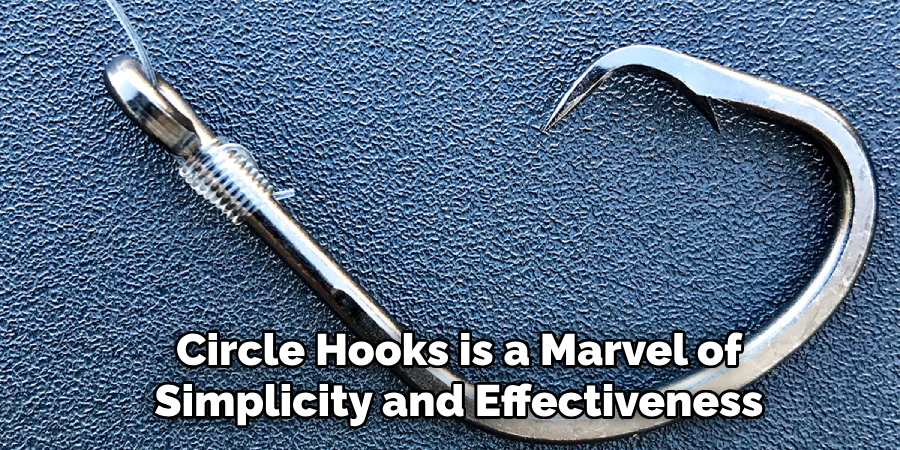
Selecting the Right Fishing Line and Hook Size
A. Choosing the Proper Fishing Line Strength for the Target Species
Selecting the right fishing line strength is pivotal in preparing for a successful fishing expedition. The line strength, typically measured in pound-test, should be chosen based on the target species’ size and fighting capabilities. Lighter lines may suffice for smaller, less aggressive fish, offering more sensitivity and a natural bait presentation. Conversely, larger, more powerful species necessitate stronger, more durable lines to withstand intense battles and prevent breakages. Balancing the line’s visibility to the fish and its strength is a crucial decision that can significantly impact success rates.
B. Selecting the Appropriate Circle Hook Size for the Bait and Fish
The size of the circle hook plays a critical role in matching the bait and ensuring the hook properly fits in the fish’s mouth for effective hooking. Circle hooks are sized by numbers and aughts, with larger numbers indicating smaller hooks up until 1, after which the sizes increase with every aught (e.g., 1/0, 2/0, etc.). Selecting the right hook size involves considering the bait and mouth sizes of the target species. A well-chosen hook maximizes the chances of a solid hook-up while minimizing harm to the fish.
C. Ensuring Compatibility Between Line Diameter and Hook Size
The compatibility between the fishing line diameter and the circle hook size is a detail that can greatly influence the effectiveness of the snell knot and overall setup. Using a too thick line for a small hook could hinder the knot’s integrity and the bait’s natural movement. On the other hand, a line too fine for a large hook might not withstand the pressure, leading to failures during critical moments. Achieving a balance ensures that the snell knot is secure and the setup is optimized for the best performance in catching the intended fish species. This synergy enhances an angler’s confidence in their equipment, allowing them to focus on the skillful art of fishing.

Preparing the Fishing Line for Snelling
A. Cutting a Length of Fishing Line
To begin the process of snelling a circle hook, it is essential first to cut a suitable length of fishing line. The ideal length is generally around 18 to 24 inches, which allows ample line for wrapping and securing the snell knot without being cumbersome. Using a sharp pair of scissors or a specialized line cutter ensures a clean cut, which is critical for maintaining the line’s integrity and preventing fraying.
B. Removing Any Twists or Kinks from the Line
Once the desired length of the line is cut, the next step involves removing any twists or kinks that may have formed. A smooth, straight line is key to forming a secure and efficient snell knot. This can be achieved by stretching the line gently between your hands or running it through a soft, damp cloth. Additionally, inspecting the line for any damage or weak spots is advisable at this stage, as these can compromise the strength of the connection to the hook.
C. Attaching the Fishing Line to the Eye of the Circle Hook
With the fishing line prepared, the final step before tying the snell knot is attaching the line to the eye of the circle hook. This is done by threading the line through the eye once and then again, creating a loop on one side of the hook. Ensuring that the line is snugly fitted through the eye without over-tightening is crucial, as this could create unnecessary wear on the line. This double-pass method through the hook’s eye provides a secure base for wrapping the line in the upcoming snelling process, firmly anchoring the hook in preparation for a successful fishing adventure.
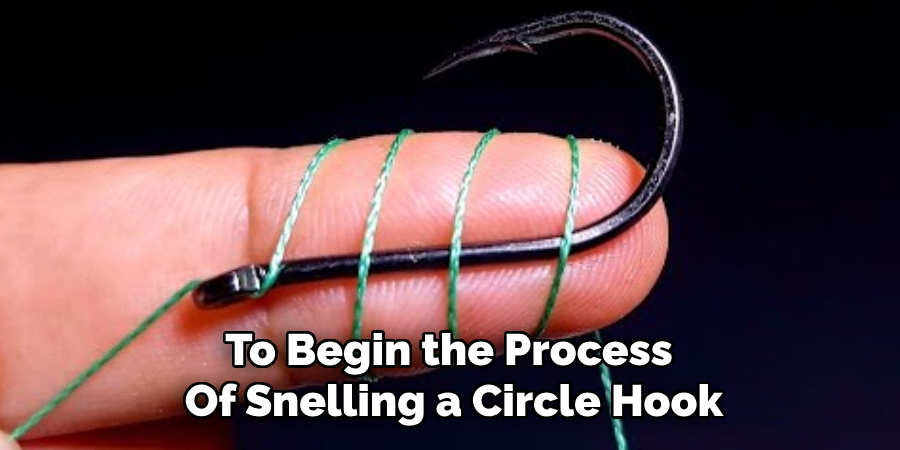
How to Snell a Circle Hook: Step-by-Step Guide
Step 1: Forming the Snell Knot Loop
Begin by holding the circle hook firmly in one hand and the line in the other. Fold the line back over itself to form a small loop above the hook, ensuring the main line runs alongside the hook shank. This loop will serve as the foundation for your snell knot, enabling the subsequent wraps to tighten securely around the hook’s shank.
Step 2: Passing the Tag End Through the Eye of the Hook
Next, carefully pass the tag end of the line through the eye of the hook from the back to the front. This direction is crucial for the snell knot, as it ensures that the wraps you will make shortly grip both the line and the hook effectively, enhancing the knot’s strength and stability.
Step 3: Wrapping the Tag End Around the Main Line and Hook Shank
Hold the loop you formed in Step 1 securely with your thumb and forefinger. Then, start wrapping the tag end around both the main line and the hook shank, beginning just under the eye of the hook. Ensure these wraps are neat and tightly adjoining each other without overlapping, as uniformity in wrapping contributes to the knot’s overall strength.
Step 4: Making Multiple Wraps Around the Hook Shank
Continue making these wraps down the hook shank, aiming for 5 to 10 wraps depending on the line’s thickness and the size of the hook. Thinner lines and smaller hooks require more wraps for adequate security, whereas thicker lines and larger hooks can achieve optimal grip with fewer turns. The goal here is to cover a decent portion of the hook shank with a tightly wound line to ensure the knot’s efficacy and durability.
Step 5: Pulling the Tag End to Tighten the Knot
After completing your wraps, gently but firmly pull the tag end of the line to begin tightening the snell knot. Simultaneously, hold the main line taut to ensure even tightening. This step may require some wrap-around adjustments to ensure they tighten uniformly without bunching up or slipping.
Step 6: Trimming the Tag End Close to the Knot
Once the knot is fully tightened and you are satisfied with its placement and security, use a sharp pair of scissors or a line cutter to trim the excess tag end as close to the knot as possible without nicking it. This final step ensures a neat, tidy finish to your snelled circle hook, readying it for baiting and subsequent fishing activities with enhanced efficiency and confidence in your tackle’s performance.
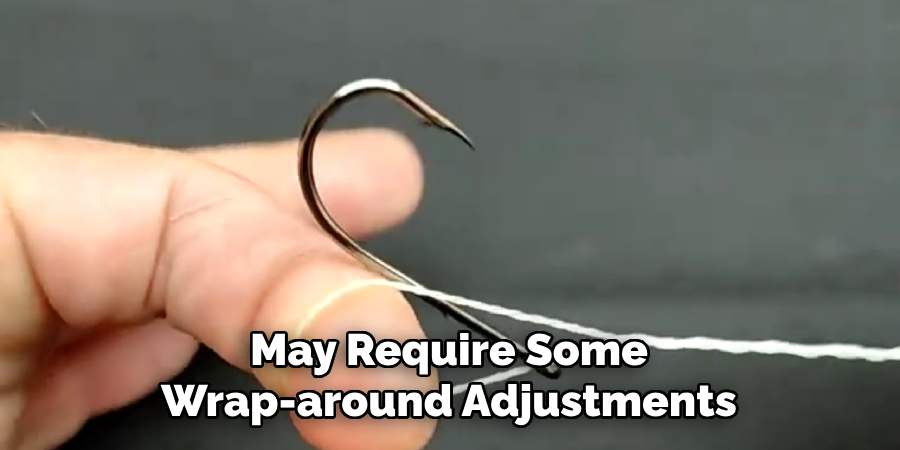
Testing the Snell Knot for Strength and Security
A. Checking the Tightness and Alignment of the Knot Wraps
Once the snell knot has been tied, it is important to first check the tightness and alignment of the wraps. Proper alignment ensures that the load is distributed evenly across the knot, enhancing its strength and reducing the risk of failure under tension. To check the alignment, visually inspect the wraps to ensure they are parallel and tightly packed without any overlaps or gaps. Gently running your fingers over the wraps can also help feel for inconsistencies that may not be immediately visible.
B. Applying Pressure to the Knot to Ensure it Holds Firmly
The next step involves applying pressure to the knot to ensure that it holds firmly under stress. This can be done by holding the hook in one hand and pulling on the main line with the other. The pressure applied should be gradual and controlled, increasing until it mirrors the stress the knot would experience during actual fishing. If the knot holds without slipping or loosening, it is considered secure. However, if there is any movement, it’s advisable to untie the knot, inspect the line for damage, and retie it, ensuring tighter wraps.
C. Inspecting the Knot for Any Signs of Slippage or Weakness
The final step in testing the snell knot’s strength and security is a thorough inspection for any signs of slippage or weakness. This check involves closely looking at the knot for any fraying of the line or widening of the wraps, which could signify potential failure points. Additionally, ensure the tag end remains neatly trimmed and does not show signs of unraveling, which could compromise the knot’s integrity. Regular inspection and maintenance of your knots, especially after catching a fish or encountering significant resistance, ensure ongoing strength and security.

Using the Snelled Circle Hook in Fishing
A. Baiting the Hook Properly with Live or Cut Bait
Proper bait presentation is crucial to maximize the effectiveness of your snelled circle hook. For live bait, ensure it is hooked once through the lip, nose, or back without impairing its ability to move naturally. This encourages the bait to behave in an attractive manner to target fish. When using cut bait, attach it in a way that maximizes its scent release yet keeps it securely on the hook. The goal is to present the bait in the most natural and appealing way possible to entice target species.
B. Casting or Presenting the Bait to Target Fish Species
The casting or presenting bait technique varies depending on the target species and fishing environment. For surf fishing or casting from a boat, ensure your cast is smooth to maintain the bait’s position on the hook. When bottom fishing, allow the bait to sink naturally, adjusting the weight as necessary to reach the desired depth while keeping the line taut enough to feel bites. For species that might be wary, consider using techniques that allow for a more stealthy presentation, such as float fishing or drift fishing.
C. Allowing the Circle Hook to Set Naturally During the Fight
One of the significant advantages of using a circle hook, especially one that’s snelled, is its ability to set itself in the fish’s mouth. It’s important not to jerk or sharply pull the rod when you feel a bite; instead, maintain steady pressure. The circle hook is designed to slide to the side of the mouth and catch securely in the corner as the fish swims away, reducing the risk of gut-hooking and facilitating easier, safer catch and release.
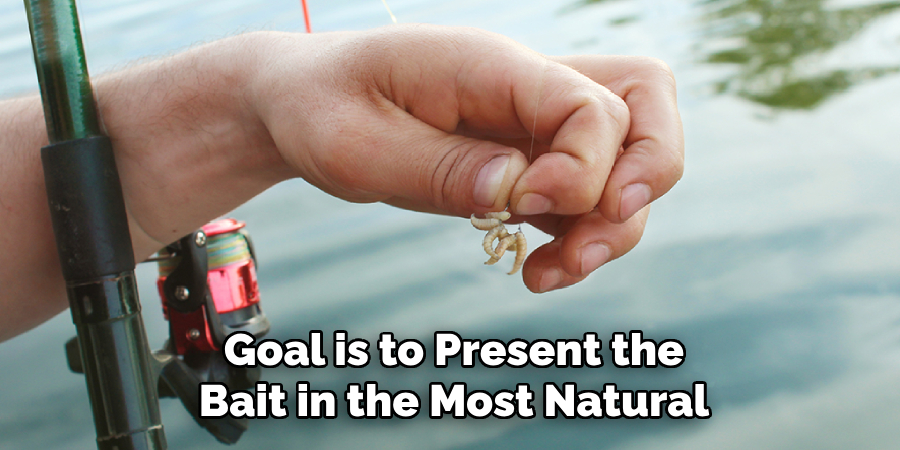
Safety Considerations
Safety should always be a paramount concern when engaging in any fishing activity. The tools and techniques involved, while effective, can pose various risks if not handled with care and respect. Below are essential safety measures every angler should adhere to to ensure a secure and enjoyable fishing experience.
A. Handling Hooks and Fishing Lines with Care to Avoid Injury
Hooks are designed to be sharp to ensure efficient penetration during the hook set. However, this characteristic also makes them dangerous to anglers if mishandled. Always hold hooks by the shank and avoid leaving loose hooks in areas where they can inadvertently cause injury. When working with a fishing line, be mindful of its tension and potential for causing cuts. Wearing gloves during knot tying or when pulling on a tight line can provide additional protection.
B. Using Caution When Casting to Prevent Accidents
Casting requires attentiveness to prevent accidents, especially in areas populated with other anglers or bystanders. Before casting, always look around to ensure that the area is clear of obstacles and people. A misplaced cast risks entangling in trees or debris and has the potential for hook-related injuries to others nearby. Practice casting techniques in open, unpopulated areas to increase accuracy and control over where your line and hook land.
C. Watching for Sharp Ends of Cut Line to Prevent Injury
Discarded fishing lines or the ends of lines cut during tackle setup can become environmental hazards if not properly managed. These lines can also pose a risk of cuts or entanglement, potentially leading to injury. Always dispose of unused or cut line pieces in a designated trash receptacle. Additionally, be cautious when handling a line that has been cut, as the ends can be sharp. Keeping a small trash bag or container for collecting these pieces while fishing contributes to both safety and environmental conservation.
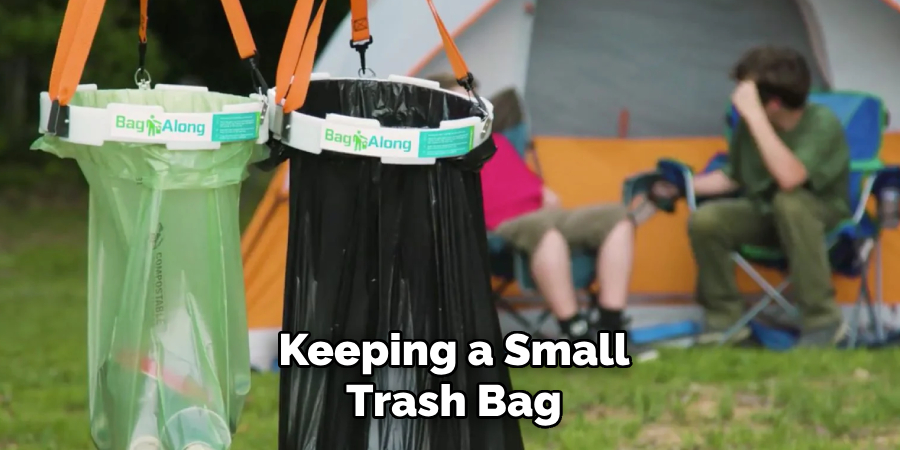
Conservation and Ethics
Fishing, while enjoyable and sometimes necessary, carries a responsibility towards conservation and ethical practices. These principles ensure that future generations can enjoy the sport while protecting aquatic ecosystems.
A. Practicing Catch and Release When Appropriate
When done correctly, catch-and-release plays a significant role in conservation efforts by allowing fish to continue contributing to the ecosystem and breeding population. To ensure the health and survival of the fish, use barbless hooks, handle fish as little as possible, and return them to the water promptly. Familiarize yourself with the proper techniques to minimize harm and stress to the fish.
B. Following Local Fishing Regulations and Size Limits
Local fishing regulations are designed not only for the safety of anglers but also for protecting aquatic populations and habitats. These rules, including size limits, bag limits, and seasonal restrictions, help to maintain balanced ecosystems and ensure sustainable fish populations. Always research and adhere to the regulations of the area you are fishing in.
C. Respecting the Environment and Other Anglers
Conservation extends beyond the water and into our interactions with the environment and fellow anglers. Practicing good stewardship involves leaving no trace at your fishing site, disposing of trash properly, and not disturbing vegetation or wildlife. Additionally, respecting other anglers by maintaining proper distance, sharing spaces responsibly, and practicing courteous behavior enhances the overall experience for the community. By adopting these conservation and ethical practices, anglers contribute to the preservation of the sport and the health of aquatic environments.
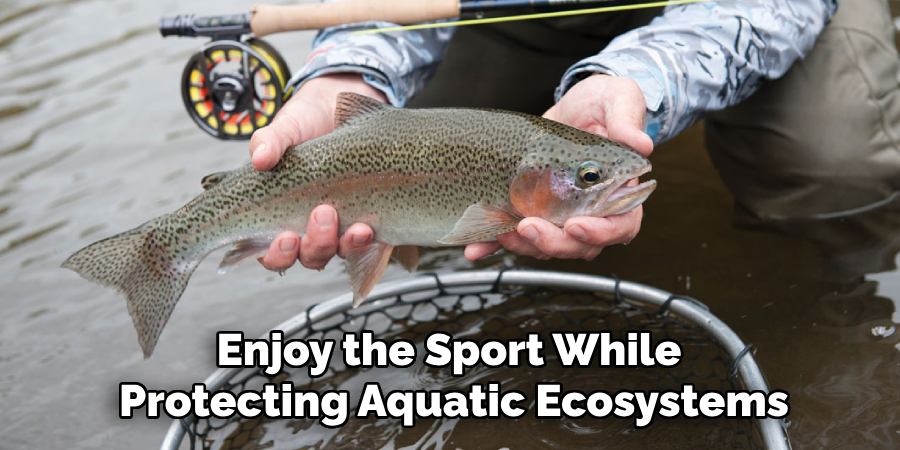
Conclusion
The process of snelling a circle hook involves threading the line through the hook’s eye, wrapping it around the shank, and securing it with a series of tight knots. This method ensures that the hook is aligned with the line, enhancing the hook’s ability to set properly in the fish’s mouth, which is crucial for a successful catch.
Mastering how to snell a circle hook may seem daunting at first, but consistent practice can significantly improve your skill level. The precision and efficiency gained through this technique can greatly enhance your fishing experience, making it a worthwhile skill to develop.
Successfully fishing with snelled circle hooks on mastering the snelling technique, understanding your target fish’s behavior, and adapting your strategy accordingly. Pay close attention to the type of bait and the method of presentation, as these are key factors in enticing a bite. Regularly check and fine-tune your gear to ensure that every component, from the line to the hook, is in optimal condition. Remember, patience and persistence are your allies in mastering how to snell a circle hook and in achieving memorable fishing experiences.
About the Author
Jennifer Branett is the author of Fishy Kayak and an expert in fish-related fields, with over 10 years of experience. Her work blends passion for fishing with a commitment to conservation.
Educational Background
Degree: Bachelor’s in Marine Biology
Institution: University of California, Santa Barbara
Specializations: Aquatic ecosystems, fish behavior, and sustainable practices
Professional Experience
Conservation Projects:
Collaborated with local organizations to restore aquatic habitats
Developed educational programs on sustainable fishing practices
Publications:
Authored articles for fishing magazines and environmental journals
Featured speaker at fishing expos and conservation conferences
Key Areas of Expertise
Fishing Techniques:
Kayak fishing strategies
Freshwater and saltwater fishing methods
Environmental Stewardship:
Advocacy for sustainable fishing
Promoting biodiversity in aquatic environments
Awards and Recognition
Recipient of the [Specific Award Name] for contributions to marine conservation
Recognized as a leading voice in the fishing community by [Organization/Publication Name]
Community Engagement
Workshops and Seminars:
Regularly hosts events to educate anglers on sustainable practices
Engages with youth programs to inspire the next generation of fishers
Online Presence:
Maintains an active blog sharing tips, stories, and conservation efforts
Engages with followers on social media to promote fishing ethics
Personal Interests
Enjoys kayaking in scenic locations
Passionate about photography, capturing the beauty of nature
Advocates for local conservation efforts in her community
